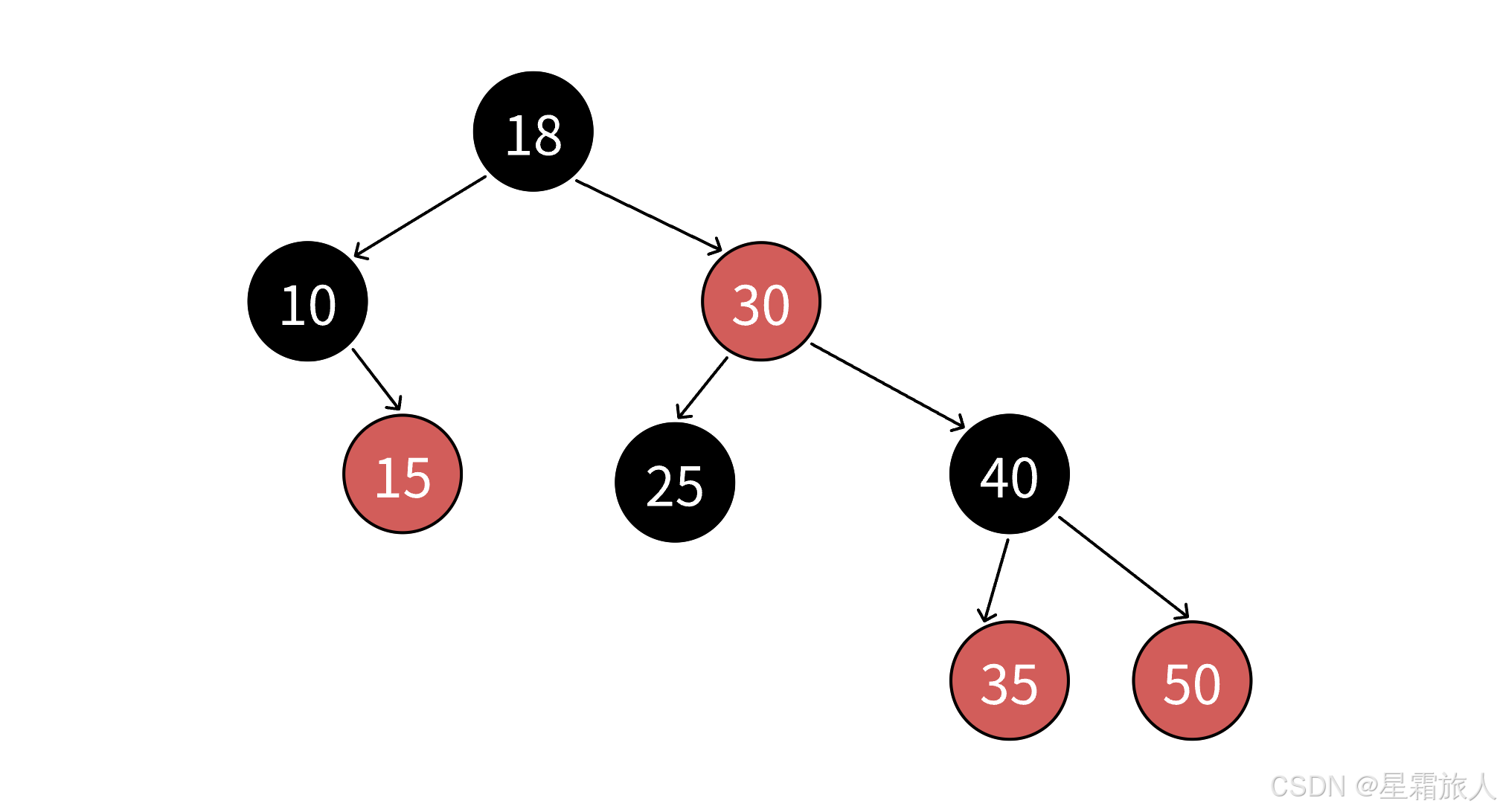欲穷千里目,更上一层楼。

前言
这是我自己学习C++的第十六篇博客总结。后期我会继续把C++学习笔记开源至博客上。
上一期笔记是关于C++的AVL树知识,没看的同学可以过去看看:
【C++】AVL树-CSDN博客
https://blog.csdn.net/hsy1603914691/article/details/147250482
红黑树
红黑树的概念
红黑树是一种二叉搜索树。在红黑树中,每个节点除了保存键值之外 ,还增加了一个额外的颜色属性 ,颜色可以是红色或黑色。
通过对从根节点到叶子节点的每条路径上的节点颜色进行约束,红黑树保证了任意一条路径的长度都不会超过其他路径长度的两倍 ,因此红黑树是接近平衡的 。
红黑树的规则
- 每个结点不是红色就是黑色 。
- 根结点是黑色 。
- 如果一个结点是红色的,则它的两个孩子结点必须是黑色的 。
- 对于任意一个结点,从该结点到其所有NULL结点的简单路径上,均包含相同数量的黑色结点 。


红黑树的效率
- 红黑树 的查找效率为 O(logN) 。
- AVL树 通过 高度差 直观的控制了平衡; 红黑树 通过 4条规则的颜色约束 ,间接的实现了近似平衡。 它们效率都是同一档次 ,但 是相对而言,插 入相同数量的结点, 红黑树的旋转次数是更少的 。
cpp
#include <iostream>
using namespace std;
enum Colour
{
RED,
BLACK
};
template<class K, class V>
struct RBTreeNode
{
typedef RBTreeNode<K, V> Node;
K _key;
V _val;
Node* _left;
Node* _right;
Node* _parent;
Colour _col;
RBTreeNode(const K& key, const V& val)
: _key(key)
, _val(val)
, _col(RED)
, _left(nullptr)
, _right(nullptr)
, _parent(nullptr)
{}
};
template<class K, class V>
class RBTree
{
typedef RBTreeNode<K, V> Node;
typedef RBTree<K, V> Tree;
public:
RBTree()
:_root(nullptr)
{}
bool insert(const K& x, const V& y)
{
if (_root == nullptr)//如果插入的节点为根节点
{
_root = new Node(x, y);
_root->_col = BLACK;
return true;
}
Node* cur = _root;
Node* parent = nullptr;
while (cur != nullptr)//找到新节点的插入位置
{
if (cur->_key < x)
{
parent = cur;
cur = cur->_right;
}
else if (cur->_key > x)
{
parent = cur;
cur = cur->_left;
}
else
{
return false;//不允许有重复
}
}
cur = new Node(x, y);
if (parent->_key < cur->_key)//插入新节点
{
parent->_right = cur;
}
else
{
parent->_left = cur;
}
cur->_parent = parent;
while (parent&&parent->_col==RED)//父节点为红色
{
Node* grandfather = parent->_parent;
if (grandfather->_left == parent)//父节点在左侧
{
Node* uncle = grandfather->_right;
if (uncle && uncle->_col == RED)//叔叔节点存在,且为红色
{
parent->_col = uncle->_col = BLACK;
grandfather->_col = RED;
cur = grandfather;
parent = grandfather->_parent;
}
else//叔叔节点不存在;叔叔节点存在,且为黑色
{
if (cur == parent->_left)//插入节点在父节点左侧
{
Rotate_Right(grandfather);
grandfather->_col = RED;
parent->_col = BLACK;
}
else//插入节点在父节点右侧
{
Rotate_Left(parent);
Rotate_Right(grandfather);
grandfather->_col = RED;
cur->_col = BLACK;
}
break;
}
}
else
{
Node* uncle = grandfather->_left;
if (uncle && uncle->_col == RED)
{
parent->_col = uncle->_col = BLACK;
grandfather->_col = RED;
cur = grandfather;
parent = grandfather->_parent;
}
else
{
if (cur == parent->_right)
{
Rotate_Left(grandfather);
grandfather->_col = RED;
parent->_col = BLACK;
}
else
{
Rotate_Right(parent);
Rotate_Left(grandfather);
grandfather->_col = RED;
cur->_col = BLACK;
}
break;
}
}
}
return true;
}
void InOrder()
{
_InOrder(_root);
}
Node* Find(const K& x)
{
Node* cur = _root;
while (cur != nullptr)
{
if (cur->_key < x)
{
cur = cur->_right;
}
else if (cur->_key > x)
{
cur = cur->_left;
}
else
{
return cur;
}
}
return nullptr;
}
void InOrder()
{
_InOrder(_root);
cout << endl;
}
bool Check(Node* root, int blackNum, const int refNum)
{
if (root == nullptr)
{
// 前序遍历走到空时,意味着一条路径走完了
if (refNum != blackNum)
{
cout << "存在黑色结点的数量不相等的路径" << endl;
return false;
}
return true;
}
// 检查孩子不太方便,因为孩子有两个,且不一定存在,反过来检查父亲就方便多了
if (root->_col == RED && root->_parent->_col == RED)
{
cout << root->_kv.first << "存在连续的红色结点" << endl;
return false;
}
if (root->_col == BLACK)
{
blackNum++;
}
return Check(root->_left, blackNum, refNum)
&& Check(root->_right, blackNum, refNum);
}
bool IsBalance()
{
if (_root == nullptr)
return true;
if (_root->_col == RED)
return false;
// 参考值
int refNum = 0;
Node* cur = _root;
while (cur)
{
if (cur->_col == BLACK)
{
++refNum;
}
cur = cur->_left;
}
return Check(_root, 0, refNum);
}
private:
Node* _root;
void _InOrder(Node* root)
{
if (root == nullptr)
{
return;
}
else
{
_InOrder(root->_left);
cout << root->_key << " " << root->_val << endl;
_InOrder(root->_right);
}
}
void Rotate_Right(Node* parent)
{
Node* ppNode = parent->_parent;
Node* sub_left = parent->_left;
Node* subl_right = sub_left->_right;
sub_left->_right = parent;
parent->_parent = sub_left;
parent->_left = subl_right;
if (subl_right)
{
subl_right->_parent = parent;
}
if (ppNode == nullptr)
{
_root = sub_left;
sub_left->_parent = nullptr;
}
else
{
if (ppNode->_left == parent)
{
ppNode->_left = sub_left;
}
else
{
ppNode->_right = sub_left;
}
}
}
void Rotate_Left(Node* parent)
{
Node* ppNode = parent->_parent;
Node* sub_right = parent->_right;
Node* subr_left = sub_right->_left;
sub_right->_left = parent;
parent->_parent = sub_right;
parent->_right = subr_left;
if (subr_left)
{
subr_left->_parent = parent;
}
if (ppNode == nullptr)
{
_root = sub_right;
sub_right->_parent = nullptr;
}
else
{
if (ppNode->_left == parent)
{
ppNode->_left = sub_right;
}
else
{
ppNode->_right = sub_right;
}
}
}
};
int main()
{
RBTree<int, int> rbt;
rbt.insert(999, 1);
rbt.insert(998, 2);
rbt.insert(997, 3);
rbt.insert(996, 4);
rbt.insert(995, 5);
rbt.insert(994, 6);
rbt.insert(993, 7);
rbt.insert(992, 8);
rbt.insert(991, 9);
rbt.insert(990, 10);
rbt.InOrder();
return 0;
}在这里获取最长路径和最短路径,检查最长路径不超过最短路径的2倍是不可行的,因为即使满足这个条件,红黑树也可能颜色不满足规则。当前看起来没有问题,但在后续继续插入节点时可能会出现问题。因此,我们应当检查四点规则,满足这四点规则能够保证最长路径不超过最短路径的2倍。
- 规则1:枚举颜色类型,这样实现可以保证颜色不是黑色就是红色。
- 规则2:直接检查根节点即可。
- 规则3:通过前序遍历检查,当遇到红色节点时查找孩子节点不太方便,因为孩子节点有两个,且不一定存在。相反,检查父节点的颜色更为方便。
- 规则4:在前序遍历中,使用形参记录从根节点到当前节点的黑色节点数量。遍历过程中,遇到黑色节点就增加黑色节点数量,遍历到空节点即可计算出一条路径的黑色节点数量。将任意一条路径的黑色节点数量作为参考值,依次比较即可。